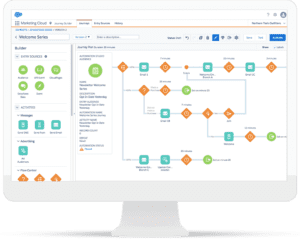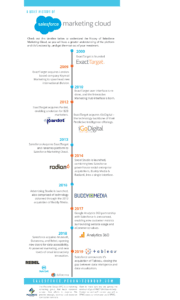Salesforce Marketing Cloud (SFMC) has taken the B2B marketing world by storm because it’s a whole different breed of marketing automation platform (MAP).
To understand what makes Salesforce Marketing Cloud so different from other marketing automation platforms, you’ll need to put yourself in the shoes of your customer. Since inception, Marketing Cloud’s technology has evolved, but with a consistent focus on the customer experience.
Salesforce Marketing Cloud has taught us that communicating with your customers is meaningless if you’re not connecting with your customers. SFMC allows you to do just that – it brings Marketing, Sales, and Service together in a beautifully orchestrated stream of communications, data sharing and machine learning. The visibility of marketing to sales & service teams delivers a better customer experience by chauffeuring the customer through the journey with personalized service and meaningful communications each step of the way.
If you're looking to make your customer experience a more 1-to-1 personalized experience, we’re going to address the 4 questions below and how Salesforce Marketing Cloud helps you win with customers.
- Why does the history of Salesforce Marketing Cloud matter?
- What makes Salesforce Marketing Cloud Journey Builder different?
- What role does data and AI play in Salesforce Marketing Cloud?
- What is the difference between a Builder and a Studio in Salesforce Marketing Cloud?
Why does the history of Salesforce Marketing Cloud matter?

Salesforce Marketing Cloud is an accumulation of multiple platforms that Salesforce purchased to accelerate the development of customer centric technology and capabilities. Here is a timeline that outlines some of those legacy platforms.
- 2000 – ExactTarget is founded. This is a B2C email service provider capable of sending emails on a large scale.
- 2009 – ExactTarget acquires London-based company Keymail Marketing to spearhead new international division.
- 2010 – ExactTarget user interface is re-done, and the Interactive Marketing Hub interface is born.
- 2012 – ExactTarget acquires Pardot, enabling a solution for B2B marketers. Pardot enables nurturing and lead management capabilities.
- 2012 – ExactTarget acquires iGoDigital – the technology backbone of their Predictive Intelligence offerings.
- 2013 – Salesforce Acquires ExactTarget and renames platform to Salesforce Marketing Cloud.
- 2014 – Social Studio is launched, combining two Salesforce powerhouse social enterprise acquisitions, Buddy Media & Radian6, into a single interface.
- 2015 – Marketing Cloud is enhanced with real-time seamless integration to other Salesforce clouds within Journey Builder.
- 2016 – Advertising Studio is launched, also comprised of technology obtained through the 2012 acquisition of Buddy Media.
- 2017 – Google Analytics 360 partnership with Salesforce is announced, enabling new customer metrics surrounding website usage and eCommerce values.
- 2018 – Salesforce acquires Mulesoft, Datorama, and Rebel, opening new doors for data accessibility (via Mulesoft’s hundreds of pre-built cloud connectors), AI-powered marketing, and new levels of email interactivity innovation.
By understanding the evolution of SFMC, you will have a greater understanding of where the platform comes from and why it’s able to do what it does.
The most recent acquisitions and partnerships show an increased focus on customer data because digital marketers today require deep insights into their customer's behaviors and interests in order to tailor a better customer journey.
What makes SFMC Journey Builder different?
At the center of Salesforce Marketing Cloud is the tool that makes all of this possible and the platform’s biggest differentiating tool – Journey Builder. The power & magic of Journey Builder is the drag-and-drop visual representation that empowers the everyday marketer to create true 1:1 multichannel campaigns tailored by profiles, behaviors, engagement, and even predictive pathways with ease. It creates unlimited possibilities for companies of any size.

The most notable feature in Journey Builder that’s overlooked by most markets is the simplicity of bringing AI into your marketing campaigns.
As marketing evolves, this is essential to optimizing your engagement and getting the most out of your efforts. For example, say you’ve put in countless hours into creating your nurture campaign, which is fully loaded with personalization and your creative is on point. Now it’s time to schedule your send, and you’re left to decide… What day/time should I start this to run so that we’ll get the most reward from all of this hard work?
The truth is, there’s never a perfect time that works for a mass blast. Machine learning lets you put Einstein (SFMC AI Widget in Journey Builder) in charge of that schedule. You see, he’s been paying attention to when the customers in your list have been opening your emails, so he can make sure that your emails are received at the optimal time. He’s pretty smart.
It may sound unimpactful that SFMC enables 1:1 marketing at scale (don’t they all?). But in reality, the difficulty implementing individual personalization is still a huge problem for marketers today. A recent survey indicated that 98% of marketers agree it’s what works, yet only 16% are satisfied with the personalization they have in place, and only 25% are personalizing emails on an individual level.
What role does data and AI play in Salesforce Marketing Cloud?
It’s no secret that in order to drive customer engagement, marketers need to be obsessed with data. You need to become more data-focused – more data-driven. Become more familiar with your data architecture. You need to know this anyway to be able to create data-driven activities, but you can also use the data to make strategic decisions…if you understand it, which will allow you to make decisions and strategies that hit at the right time.
Salesforce Marketing Cloud has given us a lot to look forward to and invest in. The recent acquisitions in 2018 show that SFMC is going to make data from outside platforms more easily accessible and build up artificial intelligence.
Data is all over the place, so marketers usually rely on IT or data resources to compile. This is a manual and time-consuming process. The biggest limiting factor of implementing the deeper personalization that marketers desire is the inability to draw insights from disjointed, disparate, and incomplete data sets. SFMC is now focusing on bringing all of that data into one place (lightening the load on IT) and delivering insights straight to the marketer through AI (no data analyst required).
Bob Stutz, CEO of Marketing Cloud, explains the vision of SFMC as they continue to expand on AI capabilities in their platform: “Relevance is the currency of the digital economy, so it’s no longer just enough to deliver personalized customer experiences — those experiences need to be smarter, faster, and in the right context. Artificial intelligence (AI) powered by machine learning will be crucial in delivering these next-gen personalized experiences for customers, and as the conductor of the customer experience, marketers need to embrace this in order to succeed.”
In fact, you can leverage the data and AI within Salesforce Marketing Cloud’s Journey Builder to build unique customer experiences that are 90% automated.!
The days of attribute-driven segmentation are over, customers want more personalized experiences and as marketers, we need to be able to deliver that. The data and AI functionalities within Salesforce Marketing Cloud allow you to start marketing based on behavior and intent, creating unique customer journeys at scale that should drive increased engagement rates and higher ROI returns.
What is the difference between a Builder and a Studio in Salesforce Marketing Cloud?
As a user of Salesforce Marketing Cloud, you should know there are many ways to accomplish similar tasks. While this can seem overwhelming initially and to the complexity of SFMC, it can also work to your advantage. For example, both Automation Studio and Journey builder will allow you to create email sequences but in very different ways, with different use-cases.
First, let’s review the six builders and seven studios that comprise Salesforce Marketing Cloud:
Builders
- Journey Builder: Build 1-to-1 customer journeys across all channels and departments.
- Content Builder: Design templates, create emails, save re-usable dynamic content blocks & manage your linked asset library.
- Audience Builder: Create audience segments with ease using a drag-and-drop tool that can filter data across subscriber attributes, engagement & predictive insights.
- Personalization Builder: Uses AI to show personalized products, content or offers to customers based on past interactions.
- Analytics Builder: Gain deeper insights into the behaviors and interests of your contacts across channels, and take a peek in the crystal ball through Einstein Engagement Reporting.
- Contact Builder: Manage, consolidate, organize, and link data from all Marketing Cloud apps and external sources.
Studios
- Mobile Studio: Create personalize mobile interactions such as SMS, MMS, MobilePush & mobile messaging apps.
- Social Studio: Listen, publish, and engage with your customers across social media channels, and create social-driven processes across your teams.
- Advertising Studio: Target 1-to-1 advertising using your CRM data to acquire and re-engage customers.
- Web Studio: Create landing pages, microsites & smart capture forms through a drag-and-drop user experience.
- Interaction Studio: Visualize, track, and manage real-time customer experiences — driving valuable engagement at the right moment, just the way your audience prefers.
Now, let’s return to our example of Journey Builder vs Automation Studio. We covered Journey Builder in greater detail above, the key advantage here is the ability to create personalized customer journeys across multiple channels. Automation Studio on the other hand, is intended for automating robust customized batch campaigns. Need the best of both worlds? No problem. Automation Studio can handle your batch audience updates and upon completion send those contacts right into Journey Builder for their 1:1 nurture.
Having multiple ways to accomplish similar tasks across all of the Builders and Studios benefits you as a marketer by ensuring that whatever tactic you are trying to implement, there is a tool in the toolbox to accomplish it. This amount of flexibility provides the opportunity to create nearly any unique customer experience you want.
The underlying theme
Salesforce Marketing Cloud has customer experience at the forefront of its evolution ... both to marketers as an SFMC customer and the customers we are trying to reach.
Want to make sure you’re getting the most out of your instance? Try our SFMC consulting services!



